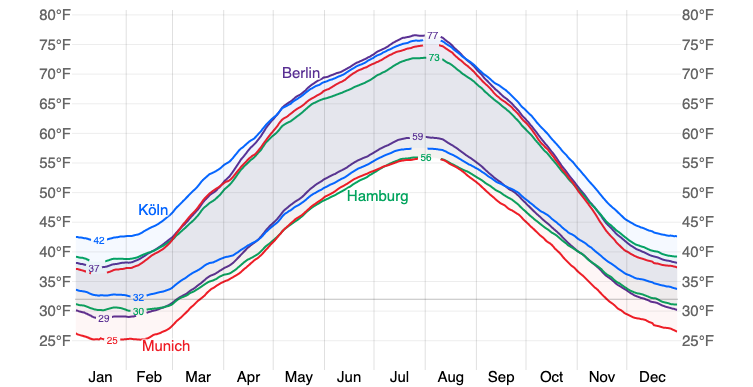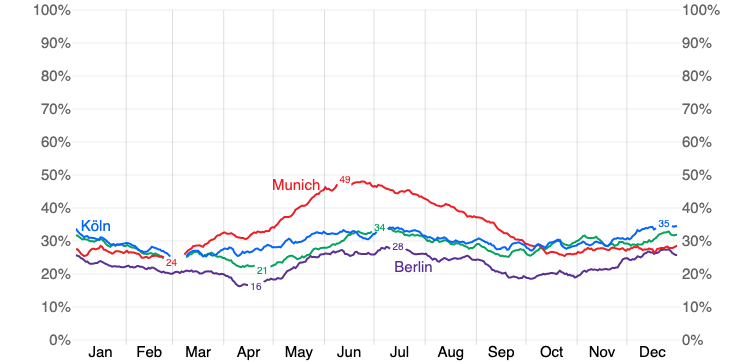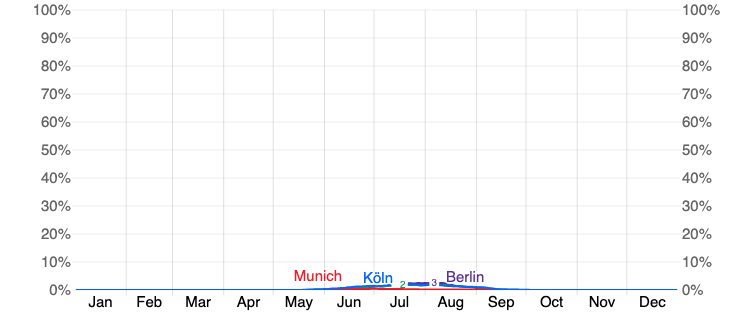There are over a hundred good reasons to pay Germany a visit: historic sites, vibrant city life, and, of course, beer! However, you’re not alone if you think this makes it your ideal travel destination.
The country welcomes over ten million tourists annually, and you’re likely to compete with the masses depending on when you go. Tourist traffic may swell around events like Oktoberfest and summer music festivals, so your chances of getting a hotel deal will shrink.
Luckily, Germany’s weather is not known for its extreme temperatures and downpours. Its weather is mostly favorable year-round, but it’s essential to look at weather trends that might disrupt your vacation.
The best months to visit Germany is April and mid-July when the weather is comfortable for sightseeing and city activities. If you’re looking for the budget travel prices for Germany, then February is the ideal time you’ll find the cheapest flights.
Biergartens aren’t so pleasant in a storm after all. This article assesses the average weather and tourist season trends to determine the best month to visit Germany for good weather and low prices. To do this, we will look at four major cities spread around the country: Berlin, Hamburg, Munich, and Köln (also known as Cologne).
Table of Contents
Average Temperature In Germany
Germany’s location in the European climate zone means it gets all four seasons, and none are too extreme. The four city’s average temperatures all hover around the same numbers.
Berlin takes first place as the hottest city with average highs of 77°F and lows of 59°F in July, the heat’s peak. Hamburg gets the coolest summer temperatures ranging from 73°F to 56°F.
Being close to the mountains, Munich has the chilliest winters as the temperature dips from 37°F to 25°F throughout the day in January, Germany’s coldest month. There’s a stark contrast between Munich and Köln, whose January temperatures jump between 42°F and 32°F.

Berlin and Hamburg also share cold winter temperatures between 29°F and 39°F until the end of February. Munich is the only city with a significant period of freezing temperatures. Berlin might experience them, but for a shorter time.
Spring sees a gradual thaw in the four cities. On the other hand, fall gradually declines in temperature, except in Munich, where it starts to cool off faster than the rest.
Daily Chance Of Precipitation In Germany
Germany gets its fair share of precipitation, some cities more than others. Rainfall is normal, but it’s not always looming around the corner. Therefore, the weather is easy to plan around in order to keep dry on your trip!
The wetter season falls during the summer months, peaking between mid-June and mid-July. Munich is again an outlier here as its precipitation chances are vastly higher than other cities in the summer. In mid-June, the city has a 49% chance of daily precipitation. Compared with the next highest at that time, Köln’s 33%, it’s clear that the Munich trip might be better off postponed until the fall when the chance drops to 27%
The drier season coincides with fall and spring, with April being the driest and mid-October a close second. Berlin is the driest city across all seasons ranging from a 16% daily chance of precipitation in April to a 28% max in July.
Are you traveling to Germany in the winter? Be prepared for the possibility of snow. Expect blankets in Munich, where snowfall reaches up to 2.9 inches on average at its peak in February.

Your chances of getting snowed on are considerably less in Berlin and Hamburg, which peaks at 1.7 inches in January and then tapers off faster than in Munich. You’re least likely to need your snowboots when visiting Köln in the winter. January sees about one inch of snowfall, and then much less in subsequent months.
Humidity Comfort Levels In Germany
Hate muggy weather? Be forewarned- you might consider moving to Germany after your trip! The country seldom receives humid weather, and for several months, the average of muggy days is zero.
In fact, you can expect zero humidity should you visit from January through May and October through December. There’s a slight chance of humidity in the summer. However, even at their most humid, Berlin and Köln get 0.6 muggy days at their July peak.

Hamburg is just behind them with 0.5 muggy days in July, and Munich never goes higher than 0.1 for the whole year.
Best Time Of Year To Visit Germany For Great Weather
Germany is blessed with excellent weather for most of the year. However, not every region is the same, and if you want to make an epic, nationwide journey, then you should keep all local weather in mind.
We’ve determined that humidity is hardly a problem to think about, so that leaves temperatures and precipitation. Summers are warm and, in some places, wet. Winters are a bit too cold for outdoor activities and can also be icy and snowy.
Two factors are used to decide the best months for weather: the “tourist score” and the “beach/pool score,” respectively. The first is used to determine how pleasurable outdoor activities like sightseeing tours are in a given month. Clear skies and temperatures between 65°F and 80°F are the criteria here.
Germany’s tourist score indicates that all four cities are best to visit in mid-July. They all share a similar curve on the chart, with Munich a bit lower on the scale due to its rainy season. Berlin barely leads the pack with a tourist score of 6.8 in mid-July.
Germany’s beach/pool score is a bit lower. Again, mid-July is the sweet spot for waterside activities, with Berlin the highest scorer at 4.6 and Hamburg the lowest at 3.3. Though the country isn’t known as a famous seaside resort destination, the summer months are still ideal for a dip in the hotel pool. September is another lovely month for a visit, as it is drier than the other fall months.
Though the two scores are highest in the summer, April is another month to consider for a German vacation. It has some of the lowest precipitation rates all year, and the temperatures, though hardly t-shirt and shorts-friendly, are perfect for city walks.
Best Time Of Year To Visit Germany For Low Prices
Western Europe and budget travel hacks go hand in hand, so when is the best time to take advantage of good deals in Germany? It depends on where you’re journey starts. The country’s cheap airline connections from other European countries are bountiful.
Carriers like Ryanair and Wizzair have daily connections to destinations all over the country. Depending on how far in advance you book, you could snag a ticket for as little as $15.
Are you coming from overseas? Finding a reasonable price is even more important if flying from North America. Summer’s peak season brings a massive influx of travelers ready to take advantage of sunny views from castles and world-class museums. Don’t be surprised by price rises on airfare of up to 28% in July and August. Hotels are bound to be busy and pricier too.
Spring and fall are quieter and cheaper, with Oktoberfest being a huge exception. If this beer-free-for-all event doesn’t interest you, traveling on the dates just before or after will have reasonable hotel prices.
February is said to have the lowest airfare costs, just so long as you don’t mind bundling up! With a lull in tourism this month, finding a cheap hotel is a breeze. Though the biergartens shut down for the season, city walks and museum visits still have plenty to offer.
If coming from afar, look at connections to either Berlin or Frankfurt. Both are gigantic international hubs, so they are sure to have the best chances of deals for long-haul flights.
When To Go To Germany
Germany’s weather is quite friendly for visits year-round, but knowing when the tourist waves ebb and flow during the tourist seasons is another important factor to consider.
Peak Travel Season In Germany
The peak season is in full swing from mid-June through August. Expect all cities to be packed full of tourists the whole summer. Flights and hotels stay consistently high during this period. Berlin and Munich are the most popular choices among international visitors, but Köln and Hamburg also get their fair share of traffic. Cologne’s architecture and scenery along the Rhine river draw in over one million tourists each summer. Hamburg gets similar numbers, as Beatles superfans make pilgrimages to the city that made the band.
Germany’s summer is nice and warm, but rainy! Expect to get wet at some point if your summer vacation takes you there. Unpredictable weather plus heavy crowds make it a questionable choice for a June or July visit.
Two more tourist rushes hit the country during Oktoberfest (late September through early October) and in December around Christmas. Munich bears most of Oktoberfest’s crowds as the festival’s home.
Over six million visit over a couple of weeks, so every room within miles of the city is sure to be full of revelers from far and wide. A bucket list experience for many, it’s simply not for everyone. Anyone not planning to attend Oktoberfest should steer clear of Munich during this window.
After the partiers pack up, the rest of the month is relatively quiet, and travel deals are typical. Christmas markets, a hit among tourists, are another draw, with tourists wanting to partake in the traditional foods, crafts, and mulled wine. Each large city hosts its own with something unique to offer at each edition.
Shoulder Travel Season In Germany
Germany’s shoulder season runs from April to mid-June, just before peak season sets in. The weeks leading up to and following Oktoberfest in early September and late October are also included. Here you can get a slice of the action before the crowds take over and even get a hotel deal while you’re at it!
April is a great month to visit most of Germany. Spring will have already warmed up the cities, and precipitation is at a low point, except in Munich. May is a solid second choice. Though the possibility of rain increases slightly, it’s warmer.
Biergartens reopen, and outdoor areas like Berlin’s massive Tempelhof Field are packed full of locals sunbathing and barbecuing.
Low Travel Season In Germany
Except for Christmas and the new year, the time from November through March comprises Germany’s low season. Though cold in some places, attractions are still open and plentiful. Take advantage of smaller crowds and check out Berlin’s Pergamonmuseum in a quieter, more peaceful setting. The low season has cheap flights and rooms aplenty, especially in February.
The low season also offers unique events that summer tourists won’t get! Cologne hosts an impressive music festival in January and an international literary festival in March. Both bring in crowds, but not enough to cause a spike in hotel prices.
Best Months For Travel To Germany
Germany should be a priority on everyone’s list. A country with rich history and traditions still living strong, it’s also blessed with great weather! This strong heritage makes it an attractive destination for millions, making it crucial to know when you should book your trip.
Though July’s warm temperatures and nonexistent humidity make it seem like the best choice, frequent rain and crowds are bound to get in the way of your fun. The period surrounding Oktoberfest and the holidays should also be off limits unless the festival and markets are your reason for visiting. The mad dash for accommodations is too much.
A less obvious choice, April is the best month to visit Germany. The month has the lowest number of wet days and is warm enough to spend the day sightseeing outdoors. What’s more, you’d be visiting in the shoulder season. Accommodation and flight prices are more reasonable.
Your chances of getting rained on are higher in Munich than the other cities. However, Munich has wetter weather on average year-round, so don’t let that scare you away from visiting the beer mecca and gateway to the Alps in the spring.




